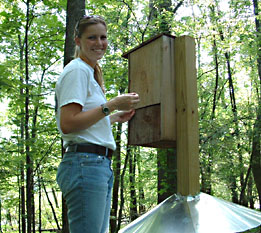
Amelia Lehman
|
|

Amelia Lehman |
![]()
|
|
AMELIA
LEHMAN
Department
of Biology
Mentor:
Terry
Derting Title of Presentation:
Nesting Success, Intraspecific Brood Parasitism, Predation, Competition,
Blood Parasites and Stress Levels of Wood Ducks (Aix sponsa) in
Clustered and Isolated Nest Boxes
Presented at: Kentucky Academy of Science Annual Meeting (1st Place Award in the Ecology Section) ABSTRACT The wood duck
(Aix sponsa) is considered one of the most beautiful of North American
waterfowl. Management attempts are often fueled by the wood duck's importance
as a game species. Population decline at the turn of the century sparked
extensive population management attempts throughout the United States
and Canada, including deployment of wood duck nest box monitoring programs.
I examined how nest box placement affected wood duck nesting success,
as well as relationships between physiological factors and box choice.
From March to July 2004 I examined nesting success, intraspecific brood
parasitism, nest predation and competition, blood parasite occurrence,
and stress levels of wood duck hens nesting in clustered and isolated
nest box sites on the Tennessee and Cross Creeks National Wildlife Refuges,
as well as Fort Campbell Military Reservation. My null hypothesis stated
that there is no difference in parameters between clustered and isolated
wood duck nest boxes. I found no statistically significant differences
in the number of eggs laid, blood glucose levels, and nesting success
and efficiency between hens nesting in clustered and isolated boxes. There
were also no significant differences in the length of bill, length of
sternum, mass, or calculated condition index. There were no significant
differences in dump nesting, interspecific competition, parasite load,
and hen age between clustered and isolated boxes. There was a marginally
significant difference in corticosterone levels, with higher levels occurring
in hens in isolated nest boxes. Future research is needed to determine
the minimum distance between boxes that will not adversely affect nesting
success and efficiency. Date Modified December, 2004
|